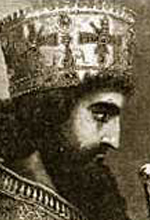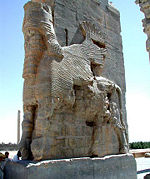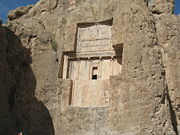Xerxes I of Persia
| Xerxes | |
| Great King (Shah) of Persia, Pharaoh of Egypt | |
|---|---|
 |
|
| Artistic depiction of Xerxes | |
| Reign | 485 to 465 BC |
| Coronation | October 485 BC |
| Born | 519 BC |
| Birthplace | Persia |
| Died | 465 BC |
| Place of death | Persia (Assassination by stabbing) |
| Buried | Persia |
| Predecessor | Darius I |
| Successor | Artaxerxes I |
| Consort | Amestris |
| Royal House | Achaemenid dynasty |
| Father | Darius I of Persia (the Great) |
| Mother | Atossa |
Xerxes I of Persia was a King of Persia (reigned 485–465 BC) of the Achaemenid dynasty. Xérxēs (Ξέρξης) is the Greek form of the Old Persian throne name Xšayāršā,[1] meaning "Ruler of heroes".[2] The English pronunciation is ['zɝk siːz].
Contents |
Early life and accession

Xerxes was son of Darius the Great and Atossa, the daughter of Cyrus the Great. After his accession in October 485 BC, he suppressed the revolts in Egypt and Babylon that had broken out the year before and appointed his brother Achaemenes as governor or satrap over Egypt (Old Persian: khshathrapavan). In 484 BC, he took away from Babylon the golden statue of Bel (Marduk, Merodach), the hands of which the rightful king of Babylon had to take a hold of on the first day of each year, and killed the priest who tried to get in his way. Therefore Xerxes does not bear the title of King in the Babylonian documents dated from his reign, but King of Persia and Media or simply King of countries (i.e. of the world). This proceeding led to two rebellions, probably in 484 BC and 479 BC.
| Darius I (by Atossa) | ||
|---|---|---|
| Xerxes | Achaemenes | Hystaspes |
| Masistes | Mandane | Saundace |
Invasion of the Greek Mainland
Darius left to his son the task of punishing the Athenians, Naxians, and Eretrians for their interference in the Ionian Revolt and their victory over the Persians at Marathon. From 483 BC Xerxes prepared his expedition: A channel was dug through the isthmus of the peninsula of Mount Athos, provisions were stored in the stations on the road through Thrace, two bridges were thrown across the Hellespont. Soldiers of many nationalities served in the armies of Xerxes, including the Assyrians, Phoenicians, Babylonians, Indians, Egyptians, Jews and Arabs.[4] According to the Greek historian Herodotus, Xerxes' first attempt to bridge the Hellespont ended in failure when a storm destroyed the flax and papyrus bridge; Xerxes ordered the Hellespont (the strait itself) whipped three hundred times and had fetters thrown into the water. Xerxes' second attempt to bridge the Hellespont was successful.[5] Xerxes concluded an alliance with Carthage, and thus deprived Greece of the support of the powerful monarchs of Syracuse and Agrigentum. Many smaller Greek states, moreover, took the side of the Persians, especially Thessaly, Thebes and Argos. Xerxes set out in the spring of 480 BC from Sardis with a fleet and army which Herodotus claimed was more than two million strong with at least 10,000 elite warriors named Persian Immortals. Xerxes was victorious during the initial battles. At the Battle of Thermopylae, a small force of warriors, 300 Spartans, and 1000 other Greeks, led by King Leonidas of Sparta, resisted the much larger Persian forces, but were ultimately defeated. According to Herodotus, the Persians broke the Spartan phalanx after a Greek man called Ephialtes betrayed his country by telling the Persians of another pass around the mountains. After Thermopylae, Athens was captured and the Athenians and Spartans were driven back to their last line of defence at the Isthmus of Corinth and in the Saronic Gulf. The delay caused by the Spartans allowed Athens to be vacated. Encountering the deserted city, in an uncharacteristic fit of rage particularly for Persian kings, Xerxes had Athens burned. He almost immediately regretted this action and ordered it rebuilt the very next day. Unfortunately the damage was done and he considered this his only mistake in his military career. At Artemisium, large storms had destroyed ships from the Greek side and so the battle stopped prematurely as the Greeks received news of the defeat at Thermopylae and retreated. Xerxes was induced by the message of Themistocles (against the advice of Artemisia of Halicarnassus) to attack the Greek fleet under unfavourable conditions, rather than sending a part of his ships to the Peloponnesus and awaiting the dissolution of the Greek armies. The Battle of Salamis (September 29, 480 BC) was won by the Athenians. Although the loss was a setback, it was not a disaster and Xerxes set up a winter camp in Thessaly. Due to unrest in Babylon, Xerxes was forced to send his army home to prevent a revolt, leaving behind an army in Greece under Mardonius, who was defeated the following year at Plataea.[6] The defeat of the Persians at Mycale roused the Greek cities of Asia.

In the Bible
The name Xerxes has not traditionally appeared in English bibles,[7] but has rather appeared as 'Ahasuerus'. While in many other more modern translations and paraphrases[8] they have directly listed Xerxes. Xerxes appears three times in the Bible: firstly as Esther's husband,[9] followed by a perfect example in the Book of Ezra[10], listing him as king of Persia in proper order after Cyrus and Darius (skipping Cambyses and the short rule of the Magi as being unrelated to the events of the book); the third reference comes from the prophecy of Daniel 11:2[11], foretelling his invasion of Greece. The reference to "Darius the son of Ahasuerus" in Daniel 9:1is unrelated.[12]
Name
While Xerxes is a straightforward Latinization of Greek Ξέρξης, the 'English' name Ahasuerus is a rendition of Biblical Hebrew Áḥašweroš, in turn corresponding to Babylonian Aḫšiyaršu. All of these names originate with Old Persian Xšayāršā. Xerxes is prononced (Zerxeese).
In the Book of Esther
For these same reasons and due to the historical context of the text, it is also commonly understood and translated that Esther's husband Ahasuerus is Xerxes the Great.[13] But the Greek Septuagint version of the Hebrew Bible identifies Esther's husband as Artaxerxes I (Longimanus), rather than Xerxes himself,[14] as does the Judeo-Roman historian Josephus.[15] Yet it is now thought that the translators of this portion of the Septuagint simply mistook Xerxes the Great for Artaxerxes I (Longimanus).[16][17]
Children
By queen Amestris
- Amytis, wife of Megabyzus
- Artaxerxes I
- Darius, the first born, murdered by Artaxerxes and Artabanus.
- Hystaspes, murdered by Artaxerxes.
- Rodogyne
By unknown wives
- Artarius, satrap of Babylon.
- Ratashah[18]
Cultural influence
- Baroque operas set to Nicolò Minato's libretto on the life of Xerxes I, derived from the Histories of Herodotus and subsequently adapted by Silvio Stampiglia and others:
- Xerse (1654), by Francesco Cavalli
- Xerse (1694), by Giovanni Battista Bononcini
- Serse (1738), by George Frideric Handel
- Xerxes is one of the major players in Gore Vidal's historical novel Creation, which spans the reigns of Xerxes's father Darius I, Xerxes and Artaxerxes I. He is a childhood friend to the main protagonist and narrator Cyrus Spitama.
- Xerxes is also portrayed, but heavily fictionalized, in the graphic novel 300 and film based on it about the battle of Thermopylae.
|
Xerxes I of Persia
Born: 519 BC Died: 465 BC |
||
| Preceded by Darius I the Great |
Great King (Shah) of Persia 485 BC–465 BC |
Succeeded by Artaxerxes I |
| Pharaoh of Egypt 485 BC–465 BC |
||
See also
- Ahasuerus
References
- ↑ Ghias Abadi, R. M. (2004) (in Persian). Achaemenid Inscriptions (کتیبههای هخامنشی) (2nd edition ed.). Tehran: Shiraz Navid Publications. pp. 107. ISBN 964-358-015-6.
- ↑ Strauss, Barry S. , The Battle of Salamis: The Naval Encounter That Saved Greece - and Western Civilization, p. 36. Simon & Schuster, New York, 2004.
- ↑ Livius Picture Archive: Persepolis - Apadana Audience Relief
- ↑ Farrokh 2007: 77
- ↑ Bailkey, Nels, ed. Readings in Ancient History, p. 175. D.C. Heath and Co., USA, 1992.
- ↑ Battle of Salamis and aftermath
- ↑ King James Version, New American Standard Bible, The Amplified Bible, English Standard Version, 21st Century King James Version, American Standard Version, Young's Literal Translation, Darby Translation, Holman Christian Standard Bible, etc.
- ↑ New International Version, The Message, New Living Translation, Contemporary Version, New Century Version, New International Revised Version, Today's New Interational Version, etc.
- ↑ Esther 1:1
- ↑ Ezra 4:5
- ↑ Daniel 11:2
- ↑ for more information on this matter see the artilce Darius the Mede, Identity of "Darius the Mede".
- ↑ New International Version, The Message, Amplified Bible, New Living Translation, Contemporary English Version, New King James Version, New Century Version, New International Reader's Version, Today's New International Version, etc.
- ↑ Septuagint; Esther 1:1,2,9...etc.; 2003 Hendrickson Publishers, ed. by Sir Lancelot C.L. Brenton; ISBN 0-913573-44-2
- ↑ Josephus, Antiquities of the Jews Book 11, Chap. 6, sec. 2; Whiston, William; The Complete Works of Josephus; Hendrickson Publishers, 1987; ISBN 0-913573-86-8.
- ↑ Sir Godfrey Driver, Introduction to the Old Testament of the New English Bible (1970)
- ↑ Wikipedia, Septuagint, Creation of the Septiagint, 5 October 2008
- ↑ M. Brosius, Women in ancient Persia.
Further reading
- Herodotus, The Persian Wars. Translated by George Rawlinson, Introduction by Francis R.B. Godolphin (1942 edition)
- A.T. Olmstead, 1948. History of the Persian Empire (University of Chicago Press) pp. 214ff.
- P. Briant, 2002. From Cyrus to Alexander: A History of the Persian Empire.
- Farrokh, Kaveh (2007). Shadows in the Desert: Ancient Persia at War. Osprey Publishing. ISBN 1846031087.
|
||||||||||||||